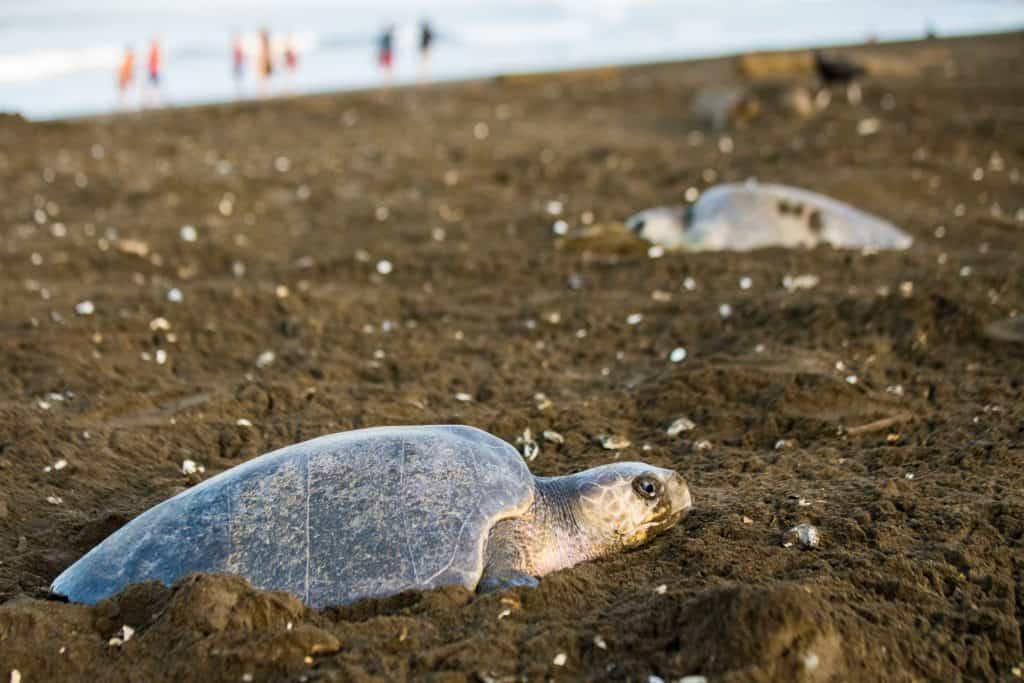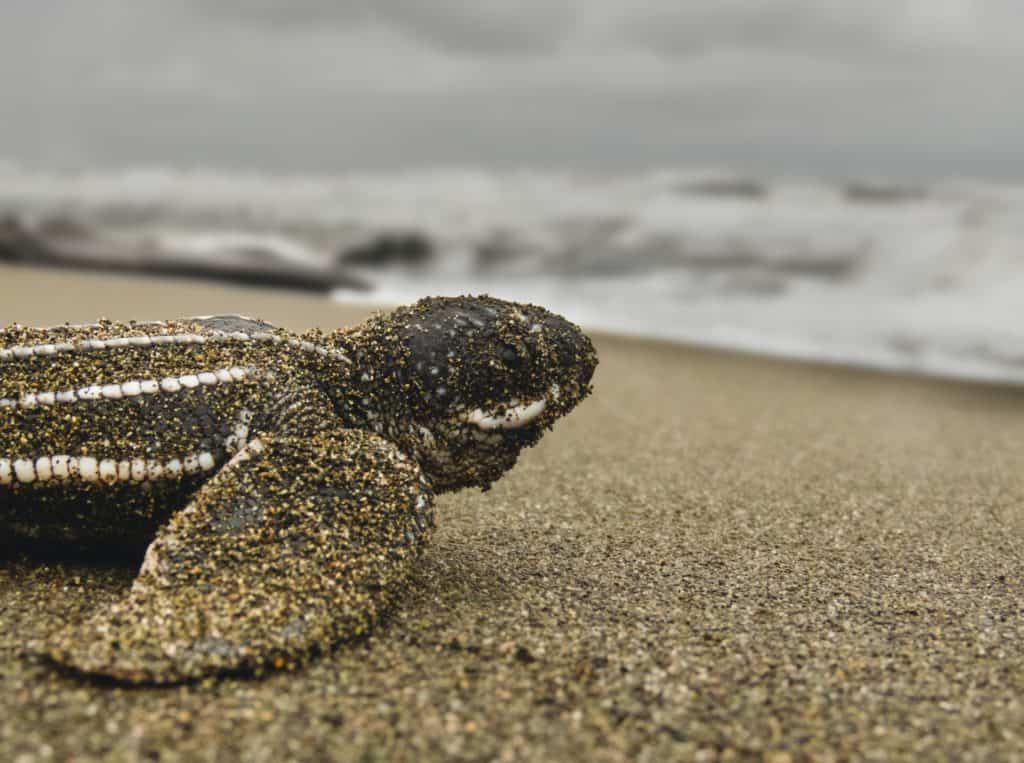
Costa Rica’s beaches are a haven for sea turtles, and Ostional on the Nicoya Peninsula stands out as the top spot to witness one of nature’s most incredible events: the arribada. This mass nesting of Olive Ridley turtles, with occasional Kemp’s Ridley visitors, draws thousands of turtles to Ostional’s volcanic sands, especially during the rainy season.
Whether you’re a wildlife lover or just curious, the arribada is a bucket-list experience. Let’s explore what makes Ostional special, why turtles gather here, and how you can see it responsibly.
What Is the Arribada?
“Arribada” means “arrival” in Spanish, and it perfectly describes the massive gathering of sea turtles that come to nest on Ostional’s shores. Unlike typical turtle nesting, where a few turtles lay eggs at a time, an arribada sees hundreds of thousands of Olive Ridley turtles—and rarely Kemp’s Ridleys—arrive over a few days to dig nests and lay eggs.
This phenomenon is most dramatic at Ostional, though smaller arribadas occur at nearby Nancite Beach. On Costa Rica’s Caribbean coast, like Tortuguero, Green and Leatherback turtles nest solo or in smaller groups, but true arribadas are a Pacific coast specialty.
Why Ostional?

Ostional’s black volcanic sand is ideal for turtle nesting, providing the right temperature and texture for eggs to incubate. Olive Ridley turtles, the stars of the arribada, have a unique trait: they return to the exact beach where they were born to lay their eggs. Since Ostional is a major hatching ground, generations of female turtles—males stay at sea—come back year after year.
The lunar cycle plays a big role, too. Turtles gather offshore during the last quarter moon, when nights are darkest, and head to shore between 8 p.m. and 4 a.m. to avoid predators. Peak arribada season runs from August to November, with September and October seeing the biggest crowds—sometimes 300,000 turtles in a single event.
Turtle Species at Ostional
While Olive Ridleys dominate Ostional’s arribadas, other species nest there in smaller numbers. Here’s a quick look:
| Species | Nesting Behavior | Peak Season | Conservation Status |
|---|---|---|---|
| Olive Ridley | Mass arribadas, 80–100 eggs per nest | Aug–Nov | Vulnerable |
| Kemp’s Ridley | Rare, small groups | Aug–Nov | Critically Endangered |
| Green | Solo or small groups | Jul–Oct | Endangered |
| Leatherback | Solo, large nests | Feb–Apr | Vulnerable |
| Hawksbill | Rare, solo nesting | May–Oct | Critically Endangered |
Kemp’s Ridleys are uncommon at Ostional, with Olive Ridleys making up 98% of arribada nesters. Green, Leatherback, and Hawksbill turtles prefer other Costa Rican beaches, like Tortuguero, for larger nesting events.
Conservation Efforts at Ostional

Sea turtles face threats from poaching, predators, and habitat loss, but Costa Rica is a global leader in turtle protection. In 1982, Ostional was declared a protected area, and by 1984, it became the Ostional National Wildlife Refuge, spanning 3 miles of coastline. This refuge, managed with the University of Costa Rica, monitors turtle populations and nests.
A unique program allows locals to harvest 1–3% of eggs during the first three days of an arribada, reducing nest destruction by later turtles and curbing illegal poaching. In return, the community guards nests from predators like vultures and dogs, helping more hatchlings reach the sea.
These efforts have paid off. Hundreds of thousands of turtles nest annually, and the population is growing. Locals, especially women and children, often guide baby turtles to the ocean, protecting them from natural predators.
When to See the Arribada
Arribadas happen year-round, but the biggest events occur from August to November during the rainy season. September and October are prime months, with some months hosting two arribadas. The largest recorded event, in November 1995, saw 500,000 turtles nest at Ostional. Turtles time their arrival with the lunar cycle, gathering offshore 10 days before the last quarter moon and nesting at night to stay hidden. You might spot stragglers nesting at dawn or midday, but nighttime is best for the full spectacle.
What Happens After the Arribada?
After turtles lay their eggs, the nests incubate for 45–52 days. Hatchlings emerge in synchronized waves, scrambling to the sea. This journey is risky—vultures, crabs, and seabirds prey on the babies, and only about 1% survive to adulthood (10–15 years).
At Ostional, community volunteers help protect hatchlings, guiding them past predators. The volcanic sand’s temperature also influences hatchling sex ratios: warmer nests produce more females, cooler ones more males, making Ostional’s climate critical for balanced populations.
How to Visit Ostional Responsibly
Seeing an arribada is unforgettable, but it requires planning. Ostional is about a 5-hour drive from San José, accessible by car or shuttle. You must join a guided tour with a licensed naturalist, as solo visits are restricted to protect turtles. Tours cost $20–$50 and run nightly during peak season. Book through local operators or the Ostional Turtle Association. Follow these tips:
- Stay Quiet and Dark: Avoid flashlights or camera flashes to prevent stressing turtles.
- Keep Your Distance: Stay with your guide and don’t touch turtles or eggs.
- Plan Ahead: September–October tours fill up fast, so reserve early.
Final Thoughts
Ostional’s arribada is a jaw-dropping display of nature, where thousands of Olive Ridley turtles transform a quiet beach into a nesting frenzy. Thanks to Costa Rica’s conservation efforts and community support, this event grows stronger every year. If you’re ready to witness one of the world’s greatest wildlife spectacles, plan a trip to Ostional, book a guided tour, and see these incredible turtles in action. It’s an experience you won’t forget!

